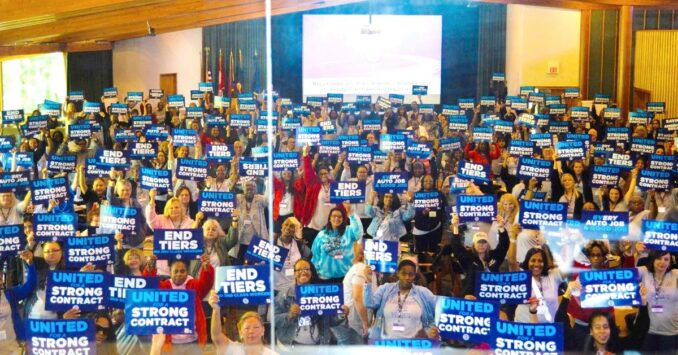UAW members reject concessionary contract demands
Contract negotiations between the United Auto Workers and Ford, General Motors and Stellantis (which includes Chrysler) began in July. Instead of engaging in the traditional handshake across the table with company executives — a photo op implying the parties were working together to achieve a “competitive agreement” — UAW President Shawn Fain visited auto plants to shake hands with the UAW rank and file. This represented a break with the class-collaborationist former leaders of the union.

Attendees at UAW’s annual Women’s Conference are ready for the contract fight, August 2023. Photo: United Auto Worker
Both parties have submitted written proposals to the other side. For the first time in decades, the UAW is making bold demands on the companies,
including substantial pay increases, elimination of tiers in wages, benefits and pensions, restoration of the cost-of-living allowance (COLA) and, significantly, a 32-hour work week at 40 hours pay.
Currently, workers at the Big Three who were hired after October 2007 are termed “in progression,” in contrast to higher-seniority “traditional” workers. After eight or more years, in progression workers make the same pay as traditional workers, but they still don’t get a traditional pension or health insurance when they retire.
Before they begin the eight-year wage progression, they may spend a number of years as a “supplemental employee,” making less pay with fewer benefits. While the UAW agreed to these tiers in the past, now “equal pay for equal work” is a key contract demand, and the workers are ready to strike over it.
The union has been stressing that over the past 10 years the three auto companies combined made $250 billion in profits off the backs of the workers. Stellantis raked in net profits of a record $12 billion for the first half of 2023.
Company proposals called ‘trash’
Fain made waves on Aug. 8 when, in a live Facebook appearance, he held up the written proposals from Stellantis and then deposited them in a waste basket. He took issue with Stellantis’ Aug. 1 statement that the company was “not seeking a concessionary agreement,” pointing to a number of concessions the company is demanding, and reiterated what the UAW is pushing for.
Fain’s righteous gesture drew howls of indignation from the corporate media and from Stellantis Chief Operating Officer Mark Stewart, who sent an email to UAW-represented employees calling the union proposal “a losing proposition.” The company claims that what the members are demanding will raise labor costs to $100 an hour, or even $150 an hour, according to “two people briefed on the matter.” (Reuters, August 11)
That is supposedly up from $63 an hour that the company, using fuzzy math, claims are current labor costs. Actually, it is a drop from the figure of $75 claimed 14 years ago, before Chrysler and GM filed for bankruptcy. The cost of living has risen significantly since 2009, but auto workers’ wages have not kept pace. With all benefits included, average hourly labor costs are probably closer to between $40 and $45 per hour.
Moreover, labor costs for the auto companies have fallen, due to a steady drop in the number of hours needed to produce a vehicle. Even if the hourly labor costs remain the same, the costs per vehicle are lower if it takes 20 hours of labor to build a vehicle instead of 25 hours.
Those five hours mean more profits for GM, Ford and Stellantis. But these cost savings — generated by the ongoing introduction of the latest automation technology, combining jobs, speedups and other capitalist means of eliminating workers — are never mentioned, especially not at contract time.
As production transitions from fossil-fuel burning cars and trucks to electric vehicles, which have fewer component parts, an estimated 30 percent fewer workers will be needed on the assembly lines. This latest restructuring could mean a huge loss of jobs.
That’s why the demand for a shorter work week — not only to give workers more leisure and family time but to offset the need for fewer workers — is absolutely critical in this round of negotiations.
It’s possible that workers at all three auto companies will be striking for a bold program of demands when contracts expire on September 14. The UAW’s current slogan, “Back in the fight,” signifies a new, overdue and welcome mood of resistance.
Martha Grevatt is a retired Stellantis worker who served on the executive boards of UAW Locals 122 and 869.

